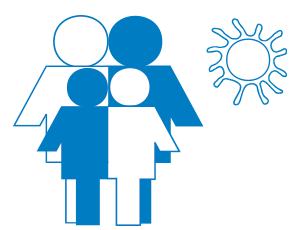Appx F-1 Adolescent Fact Sheet - New Jan 2021
Appx F-1_Adolescent Fact Sheet_revised Jan 2021_New.docx
OPRE Study: National Survey of Child and Adolescent Well-Being Second Cohort (NSCAW III): Data Collection [Longitudinal Study]
Appx F-1 Adolescent Fact Sheet - New Jan 2021
OMB: 0970-0202
Appendix F-1: Adolescent (11-17) Fact Sheet
|
Questions and Answers about the National Survey of Child and Adolescent Well-Being
|
What is the National Survey on Child and Adolescent Well-Being?
 This
is a nationwide study of children and families who have had contact
with the child welfare system. The government wants to learn about
the needs of youth and to improve programs and services for youth. We
are talking to 4,500 kids across the United States about this study.
The interviewer will also talk to parents of youth or the person who
provides the most care. We will use this information to learn about
the needs of children and families and about the kinds of services
they use.
This
is a nationwide study of children and families who have had contact
with the child welfare system. The government wants to learn about
the needs of youth and to improve programs and services for youth. We
are talking to 4,500 kids across the United States about this study.
The interviewer will also talk to parents of youth or the person who
provides the most care. We will use this information to learn about
the needs of children and families and about the kinds of services
they use.
Why should I take part?
 By
taking part, youth have a chance to talk about their needs and
experiences from their own point of view. Youth will receive a $20
gift card plus a small gift of equal value for completing the survey.
By
taking part, youth have a chance to talk about their needs and
experiences from their own point of view. Youth will receive a $20
gift card plus a small gift of equal value for completing the survey.
Who is doing this study?
The federal government sponsors the study. A research company hired by the federal government will carry out the study. The researchers are not connected with the child welfare agency.
How was I chosen?
 In
doing this survey, we cannot talk to everyone in the country. That
would cost too much and take too long. We selected a sample of
children at random who have had contact with the child welfare system
during the past 12 months. We want to interview selected youth about
their life experiences, health, behaviors, and transition to
adulthood.
In
doing this survey, we cannot talk to everyone in the country. That
would cost too much and take too long. We selected a sample of
children at random who have had contact with the child welfare system
during the past 12 months. We want to interview selected youth about
their life experiences, health, behaviors, and transition to
adulthood.
Tell me more about my involvement.
For youth who agree to join, an interviewer asks questions about the kinds of things youth can do, how youth behave at home and school, and other life experiences. The questions will focus on health, how youth feel about their family and friends, and their use of services. The interviewer will also ask about the community in which youth live, and about things that may happen in life like violence in the home, involvement with police and risky behaviors such as sexual activity and drug use.
How is the study conducted?
 A
local interviewer will contact parents and caregivers of selected
youth to schedule a personal visit to homes to describe the study,
secure parental permission, and conduct the interview. The
interviewer will read the questions from a computer screen and type
the answers into the computer.
A
local interviewer will contact parents and caregivers of selected
youth to schedule a personal visit to homes to describe the study,
secure parental permission, and conduct the interview. The
interviewer will read the questions from a computer screen and type
the answers into the computer.
How long will it take?
The interview lasts between 90 and 120 minutes. We will schedule the interview at a time convenient for those selected to take part.
 Are
the questions personal?
Are
the questions personal?
Some questions may seem personal to some people. All collected information is kept private. Youth who choose to take part do not have to answer any question that they do not want to answer.
What happens to the information?
Survey responses are collected using a secure computer and labeled with an identification number. We send the collected information to the research team through the computer in a safe and secure way. We combine answers with other interviews and report in summary form.
What about privacy?
All staff members and interviewers have signed a Privacy Agreement promising they will not reveal any information to anyone other than the research team. We have a paper from the government that promises that we do not have to share survey responses with anyone. The research team will not share survey responses with anyone unless we are worried about someone’s safety.
| File Type | application/vnd.openxmlformats-officedocument.wordprocessingml.document |
| Author | Keeney, Jennifer |
| File Modified | 0000-00-00 |
| File Created | 2023-07-29 |
© 2025 OMB.report | Privacy Policy
